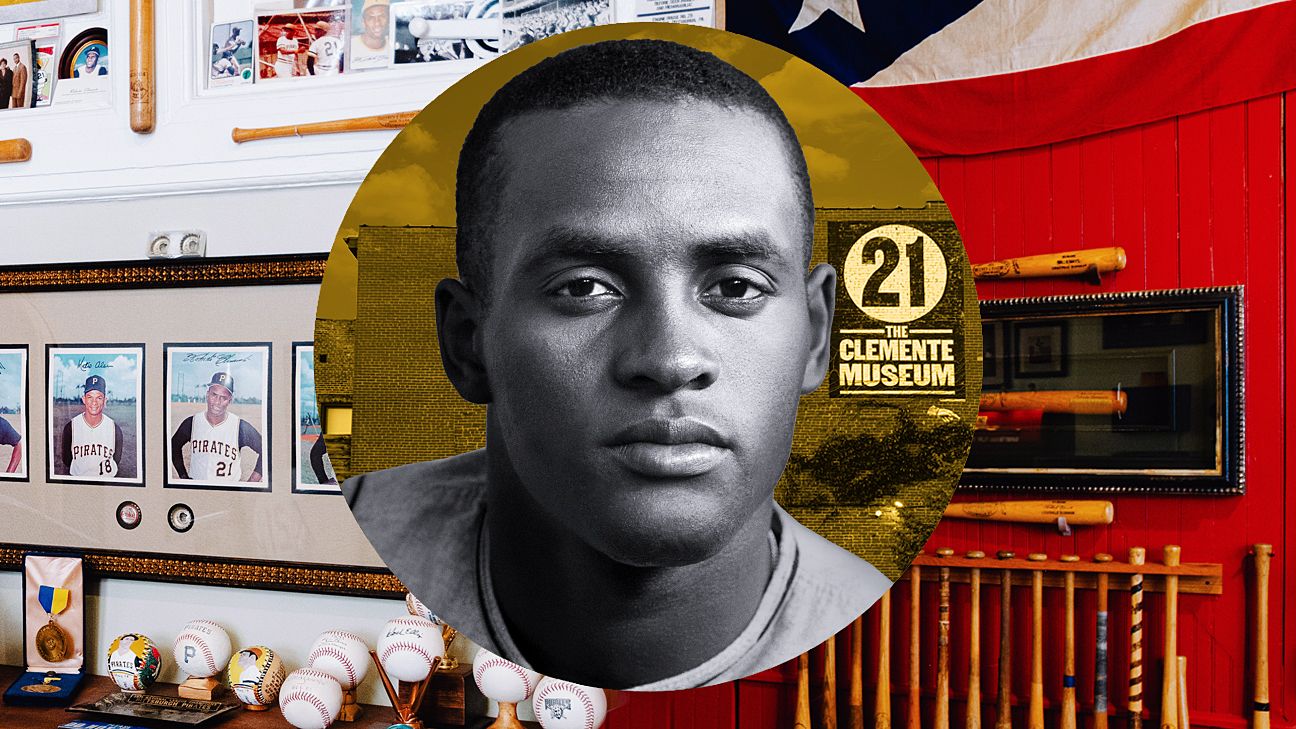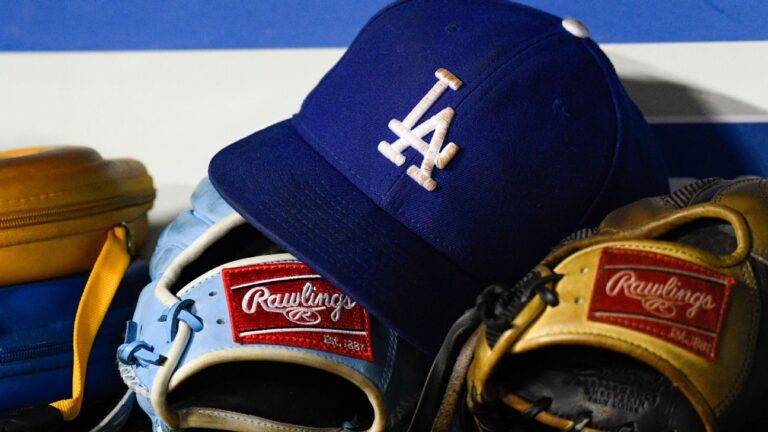-
Howard Bryant, ESPN Senior WriterSep 15, 2024, 07:30 AM ET
- Senior Writer, ESPN
- Author of “The Last Hero: A Life of Henry Aaron”
- Author of “Juicing the Game”
- Author of “Full Dissidence”
IT WAS A JOURNEY that was never intended to be a quest. Life simply turned it into one — life, plus a single motivating sentence from the most influential of voices, assisted by a dose of divinity.
One day nearly 20 years ago, Vera Clemente, widow of the legendary Roberto Clemente, entered the studio of photographer Duane Rieder before the 2006 All-Star Game, to be played at Pittsburgh’s PNC Park. The studio had once been an old firehouse — Pittsburgh’s Engine No. 25 — situated in the Lawrenceville section of the city. Built in 1896, the structure had been condemned when Rieder purchased it from the city in 1994 for the grand sum of a dollar.
Rieder had been preparing a pre-All-Star party for the Clemente family and adorned his studio with striking photos of Clemente as well as an archive of Clemente memorabilia and ephemera he had been collecting for the previous decade. He had met Vera after he had created a calendar of Clemente photos to commemorate the last All-Star Game at Pittsburgh’s Three Rivers Stadium in 1994. The following year, Rieder had assisted Vera in restoring damaged photos of the Clementes’ visit to the White House with President Nixon following the 1971 World Series, the moment that cemented Roberto Clemente nationally as what he had been known as locally for the previous 16 seasons: a transcendent great.
Editor’s Picks
2 Related
The photos were of particular importance to Vera, who lost her husband in one of the greatest tragedies in the history of American sports. On New Year’s Eve 1972, Clemente’s hastily loaded plane carrying relief supplies to Nicaraguan earthquake victims crashed into the Atlantic Ocean shortly after takeoff from Puerto Rico. Financial difficulty and indignity followed: Locals began stealing valuable Clemente items from the family home in Puerto Rico, including Vera and Roberto’s wedding album.
When she entered Rieder’s studio, she saw the striking photos of Clemente on the studio walls, including “Angel Wings,” the famous shot of Clemente stretching to make a catch while the clouds behind him seem to form a pair of wings behind his shoulders.
“Duane,” Rieder recalls Vera telling him, “You should make a museum of this place.”
Rieder then presented Vera Clemente with a priceless gift he had acquired from years of “calling in favors” and kismet — a photo album of pictures from the wedding she had never seen before.
Less than 60 days later, the Clemente Museum opened, and a life’s work would transform a building once condemned.
“I’m going to give Roberto and the Big Guy upstairs a lot of credit,” Rieder says, “for the things that evolved in this building.”
Priceless memorabilia from the museum, including Clemente’s game-worn and signed cleats, glove and road bag, have been collected over decades to provide visitors with an honest history of the baseball legend’s life. Aaron Ricketts for ESPN
THE CLEMENTE MUSEUM
THE CLEMENTE MUSEUM is a 12,000-square-foot homage to the man Pittsburgh has called “The Great One” for more than a half-century. According to Rieder, 10,000 visitors come to the museum annually. The nonprofit museum is not affiliated with the Pirates or Major League Baseball, and the money to keep it running comes from baseball die-hards, deep-pocketed Clemente die-hards — Rieder credits Eddie Vedder, the frontman for the rock band Pearl Jam, with keeping the doors open during the pandemic. Credit also, of course, belongs to the soul, spirit and sweat of the museum’s owner.
The Clemente Museum is accessible by appointment only and functions largely on the honor system — few of the 650 or so Clemente items are protected from the public by casing and so the museum trusts its patrons to not touch items or try to steal them. The converted firehouse can feel dark and foreboding with its heavy woods, a portal back into the 19th century of handlebar mustaches and horse-drawn fire carriages. Touches of the old firehouse remain — two holes in the first-floor ceiling, one still with its fire pole. The other was removed to make room for the front door.
When it is lit, the museum transforms into a shrine that feels uniquely Pittsburgh — an original baseball town since 1882. The museum is approached by fans, celebrities and big-league players as a pilgrimage and sanctuary. Manny Machado, the Padres third baseman, spends the night at the museum at least once a season. Virtually every visiting team makes a late-night stop after games, to pay tribute to The Great One, and also to relax in the basement of the speakeasy-style winery, wood-fired oven and cigar bar (named after Pirates catcher Francisco Cervelli) that is the basement. Many of them take turns swinging the massive 38-ounce bat the 5-foot-11, 175-pound Clemente swung. During a recent four-game series with Washington, 34 members of the Nationals came to the museum. One of them was Darren Baker, 25, who made his big-league debut this month. He was amused to come across a 1968 photo of a 19-year-old Dusty Baker in the Marines hanging on the wall — according to legend, Dusty broke Clemente’s Marines record for pullups. Dusty, of course, is Darren’s father and a legend in his own right. Yet for every anecdote, irony and eerie coincidence that lends the impression that the space was ordained, there is three decades of sweat behind it that give the stories meaning, that make them real.
Without Rieder, a 63-year-old with the spirit of a college freshman, physically pulling the electrical wires and knocking out part of the ceiling, revealing the original Carnegie Steel beam with the No. 21 on it — signifying the 21-inch thickness of the beam — the coincidences would have remained buried, or worse, nonexistent, bulldozed by time, progress, new structures erasing old history.
“The stories come to this building because we saved it,” Rieder says.
When the firehouse closed in 1972 — largely because of age and because the new trucks were so big they could no longer fit through the wooden doors of a building built in the 19th century — Engine 25 served as a hub for EMS vehicles. By the early 1990s, the buildings were in disrepair and the city had agreed to tear down more than a dozen of the old firehouses. Engine 25 was condemned when Rieder first looked into buying it. It was, he says, a “haven for pigeon poop and rats.”
“This part of town, Lawrenceville, was a mess,” he says. “People told me I was crazy buying here. The neighborhood was in such bad shape, you were taking your life into your own hands parking on the street … and the place needed so much work. It had no running water. Estimates were running me $500,000 in renovations.”
In 1994, Rieder settled on another studio, in Polish Hill. The papers were signed. The deal had closed. Engine No. 25 faced another destiny against the wishes of angry Lawrenceville residents: It was scheduled to become a nightclub. There was no way out, until Jimmy Ferlo, the powerful city councilman of the 7th District, stepped in. “I said, ‘Jimmy, there’s no way out. We’ve closed,” Rieder recalls. “Jimmy said, ‘Do you want it, yes or no?'” In a scene that sounds like a movie, Ferlo ripped up Rieder’s closing papers on the Polish Hill spot, and the move to the firehouse was miraculously done.
The Clemente Museum is located in the former Engine House No. 25 in the Lawrenceville section of Pittsburgh. The founder purchased the property for $1. Aaron Ricketts for ESPN
The firehouse was haunted by a dark coincidence: Engine No. 25 permanently closed its doors on Dec. 31, 1972, at 9 p.m. ET; a thousand miles away and about 20 minutes later, Clemente’s plane had just taken off and began its fateful descent. Undeterred, Rieder renovated the building, piece by piece. A welder by trade who refers to himself as “severely dyslexic,” Rieder put his life into the building. Sanding the floors. Scavenging for wood and coal. Renovating the original tin panels that adorn the second-floor ceiling. Finding old pieces — like the filing cabinet from a nearby printing press. Rescuing old photos, like Angel Wings, from the trash.
Rieder met Vera Clemente the following year, and he began to archive Clemente materials. A vision of a museum was taking shape — but did not become one until Vera Clemente’s suggestion more than a decade later.
“If I wasn’t a photographer and a workaholic, this couldn’t have happened,” Rieder says. “Who could do this? Even if you had all the money in the world, could you do this? Because it wasn’t about money. And I’m not bragging when I say this kind of stuff. It was just piece by piece, putting your work into your interests.”
When the museum officially opened in 2006, Rieder had been working on the building for a dozen years. In between, he honed another craft, learning to make wine. First photography. Then wine. Then baseball. “Every Italian in Pittsburgh made their own wine,” he says. “I started making dago red. It was just a hobby at first.” Now, big-league players from Pete Alonso to Ryan Zimmerman to Josh Bell have barrels of wine in the cellar speakeasy as part of Rieder’s wine club.
Sarah Kelsey, a part-timer at the museum with a soothing voice and gentle demeanor, did not come to the Clemente for the baseball. She is originally from Arlington, Virginia, but needing a life change seven years ago, she arrived in Western Pennsylvania. She now speaks of the region — and the Clemente — as a place of soft refuge. She met Duane Rieder for the wine, and remained for the architecture, the community, what she referred to as the magical nature of the building — the cherry floors in the basement, sloped slightly to the right because the firehouse, built in 1896, once doubled as a horse stable in the days before fire trucks and the floors needed to be sloped for drainage.
On the second floor, the light pierces the wide room as though through stained glass, accentuating the wide-plank floors, and the original woodwork. The second floor contains catnip for Clemente fanatics: the 1961 silver bat commemorating his first batting title, dented because his kids used it to hit. The museum is for Kelsey a place of peace. “It is a beautiful building,” she says. “The building feels safe. Every time I come here, I see something new, and I hear something new. It is a very uplifting place. People are moved by it. I’m happy and humbled, and lucky to be here. When people come here, they want to talk about their lives. They want to donate things — albums, cuff links. They feel the need to share.”
Three times the museum has been saved, by luck or divinity. In 2006, Rieder’s most famous photo — of the Steelers praying before a game — went viral after a television station did a story on Rieder before the Steelers-Seahawks Super Bowl. The selling of the iconic print saved Rieder from a tax accounting error that put him in arrears. “I paid off the IRS,” he says. “Sixty thousand. In cash.”
In 2009, the museum nearly burned to the ground. “It was my fault,” Rieder says. “I was doing the plumbing. I was heating up the copper pipes with a torch, and it caught on to the insulation and started burning. The power went out, and I was in total blackness. I saw a ball of fire. I could see it behind the drywall, so I punched holes in the drywall with my fist, found the piece of insulation and stamped it out. Then, I fixed the pipe and went home.”
In 2020, the pandemic nearly closed the shrine. But Eddie Vedder saved it. “He filmed a video for us, like a virtual fundraiser,” Rieder says. “He sent a guitar signed by the whole band. We auctioned everything off and raised $100,000.
“We were closed for almost two full years and the bills were piling up. He supports a hundred charities, and we were lucky to be one of them. So, thank the Lord for Eddie Vedder.”
Clemente, of Afro-Latino heritage, made his major league debut in 1955, eight years after Jackie Robinson became the first Black player in the history of MLB. Bettmann Archive/Getty Images
THE LORE OF ROBERTO CLEMENTE
IN THIS TOWN, Clemente endures as perhaps no other player in any other big-league city. He is not claimed in the way of a Ruth or Williams or Mays — respected for the memories, awed by their abilities. Nearly 70 years after his major-league debut and 52 years after his death, Clemente stands closer to Henry Aaron, not just admired, but revered. The main bridge crossing the Allegheny River leading into PNC Park is the Roberto Clemente Bridge. At the foot of the bridge is the Clemente statue. At the stadium itself, there are distractions for kids, and a bar in center field for adults, and perhaps the best views in baseball, all animated by the excitement generated by rookie fireballer Paul Skenes, but it’s the Clemente images throughout that make watching a game here feel grounded. In the team shop at the stadium, Clemente jerseys are still prominently displayed. He remains the city’s conscience.
Art Rodriguez, a retired dentist who works at the museum with an almost ancestral connection to it, conducts many of the private tours. Rodriguez still owns the scorecard from his first baseball game: July 28, 1968, at Forbes Field. The Cardinals were in town. The Pirates won 7-1. Clemente, the son of a cane crop worker, went 3-for-4 with a triple and two runs scored. Rodriguez and his father, Archie, stopped scoring the Cardinals after the second inning. The Pirates kept their attention until the sixth, when Clemente struck out to end the inning. Bob Gibson didn’t pitch that day, but Rodriguez would never forget the aura of Gibson while trying for an autograph: green turtleneck, gold chain. No signature. Rodriguez was seven years old.
Rodriguez grew up in Donora, about 30 miles from Pittsburgh, birthplace of the famous Stan Musial, and Ken Griffey Jr. It was Musial that connected the Rodriguez generations to baseball, and it was work that drew the family to Pittsburgh. His grandfather on his father’s side, Manuel, came over from Oviedo, Spain, in 1917 and worked in the Western Pennsylvania zinc mills. On his mother’s side, his grandfather, Dominic, came to America from Ceto, Italy, in 1913 and worked in the coal mines. Their story was the immigrant-American story: the grandparents, one set from Spain, one from Italy, spoke some English and had no interest in sports. The next generations became American through sports, the father with Musial, the son, Clemente.
During his tours, Rodriguez does not revel in Clemente’s prodigious statistical achievements — a .317 career average, 3,000 hits, four batting titles, 12 straight Gold Glove awards — as much as he focuses tourgoers on the man and the price he paid during his times. Clemente faced the discrimination of the Black players of his era and the anti-Latin sentiment common in baseball. Reporters would quote Spanish-speaking players phonetically, as if to mimic their poor English. Clemente resented attempts to Americanize him. The museum features several editions of Clemente cards where his name is listed as “Bob Clemente” instead of “Roberto.” For years, Clemente internalized those resentments before challenging his teammates as athletes and as men.
“I really emphasize the racism he faced, and yet he was so stoic,” Rodriguez says. “He had a way of getting to people. He knew he probably should speak out. He could convey that if you were a bigot, you couldn’t be a good man, and that resonates so much to the messages of today.”
In his tours, Rodriguez senses when visitors recognize the parallels between the xenophobia Clemente faced as a player and the nation’s current divisions. Before winning over the baseball world with his play and humanitarianism, Clemente endured the rising sentiment within the sport that baseball had hired too many minorities and, despite the greatness of him and players like Mays and Aaron, the game was diminished because of integration.
“If you’re Black or an immigrant, the message is ‘You have ruined our country,’ and that is the appeal,” Rodriguez says, alluding to the rising political rhetoric over the past several years and its parallels to the Clemente years. “I guess coming from a family of Spanish and Italian immigrants, I relate to whom those comments are directed. He didn’t say it. His supporters didn’t say it. But that is the feeling. I’m blown away by it. If someone had told me that racism would be as present to the degree as it was during Clemente’s time, I wouldn’t have believed it. It’s really important for the young people to understand.”
Clemente is an indelible part of American mythology. So is baseball. So is Pittsburgh. The reverence is rooted in the rare person who died as he lived and thus is not diminished by time. The Pirates won two World Series during the Clemente years, but the Pirates and his legend are uncomplicated because the Steelers during the 1960s were not the great team they would become. Then there is Pittsburgh, the Steel City of unpretentiousness and integrity people like to believe they embody — but most often do not.
Duane’s wife, Kate, definitely does. She is a shy, funny woman with mischievous eyes who says far less than she is thinking. Where people will refer to her husband as “the mayor of Pittsburgh” for his indefatigable gregariousness and constant availability, Kate Rieder is the opposite — and often provides the governor to her husband’s limitless generosity. It is common for the Rieders to get a late-night phone call from MLB players or coaches — the Nationals manager Davey Martinez, for instance — who want to pop by the museum for cigars, a glass and soak up the aura of The Great One. “I don’t do the public thing,” she says. “It’s fine as long as I don’t have to do it.” She grew up in the South Hills area, repeating, in a small sense, part of her childhood. Her father, an old New Englander and die-hard Red Sox fan from Nashua, New Hampshire, who became synonymous with Pittsburgh, was known all over town, the legendary KDKA-TV meteorologist Bob Kudzma. Kudzma was on the air for 34 years. But unlike Duane, who is naturally extroverted, Kate Rieder remembers her father, who passed away in 2021 as a private man with a public occupation. Off-camera, she says he kept to himself and his family.
She marvels at Duane’s energy. “He always finds time to create every thing. He never stops. He helps people. He’s super thoughtful. He’s like the Energizer Bunny.”
Nick Barnicle, a film producer who shot a documentary, including of Duane’s Clemente collection and spent extensive time with them at the museum, said, “Kate is the Landau to Duane’s Springsteen. The Robin to Duane’s Howard. The Varitek to Duane’s Pedro. Without Kate, it’s just not the same.”
Duane Rieder, owner of the Roberto Clemente Museum, stands in front of a mural outside his establishment. Aaron Ricketts for ESPN
THE PROPELLER
BRIAN, THE UBER DRIVER taking me to the museum on a recent late-summer day, drives in silence for several blocks before glancing again at his phone to confirm my destination. “The Clemente Museum,” he says evenly. His tone is curiously monotone — something bothers him. Through several red lights, Brian finally reveals the mystery of his ambivalence. “The propeller is in there,” he tells me. “It’s right there. That has never sat well with me.”
To the left of the front entrance of the museum, at roughly 11 o’clock, sits a vertically rectangular plexiglass case protecting a lone, damaged gray-black propeller blade. It is one of the blades from the DC-7 that plunged Clemente fatally into the Atlantic. After the crash, the newspapers showed the photos from Puerto Rico, of the search and rescue. The most prominent one featured Pirates catcher Manny Sanguillén, the only teammate to go into the water as part of the effort, heartbroken, trudging waist-high through the surf.
In 2013, St. Louis came to Pittsburgh, and Carlos Beltrán, the star Cardinals outfielder and another in the line of great Puerto Rican players, visited the museum. Soon after, Beltran told Rieder of a find: The father of Beltran’s friend was the captain of the Coast Guard ship that pulled the plane wreckage from the sea.
“I later get a call from Carlos’s friend, an architect named Angel, who was helping Carlos design his academy,” Rieder says, staring into the case. “He says, ‘Sit down. I want to send you a picture.’ A photo of a propeller comes. It’s laying in his buddy’s garage. He says, ‘Would you ever want this?’ And I went, ‘Holy cow. Is that the propeller from the plane?'”
Rieder acquired the blade at the end of 2013, and the next year began displaying it full time in the museum. But not before dealing with the question of displaying the blade — whether its appearance in the museum was necessary or gratuitous — in an emotional meeting with Vera Clemente and her three sons, Maurice, Ricky and Roberto Jr.
“There had been an auction house in Puerto Rico selling off parts of the plane,” Rieder says. “And the family said to please take those items out of the auction. So later, the family is coming to Pittsburgh to talk about Clemente Day. They say they’re coming over. I said, ‘OK, head’s up: I have a piece I want to talk about and you guys can vote. If you say it stays, it stays. If you say it doesn’t, it goes. So they show up and I had it in the middle of the room. I had it covered with a black piece of cloth. So I pulled off the tarp, and Vera, Maurice and Ricky all said, ‘OK. I think it should be here.’ A museum should tell the truth, should tell the story. Roberto Jr. got very emotional and ran out the door.”
Rieder had his own reason why he felt it necessary to display the propeller: to dispel the myth that the plane was never recovered. “Roberto’s body was never found,” he says. “That part is true, but we do hundreds of tours and someone in the tour always makes mention that the plane was never found. All Puerto Ricans know they found the plane. They stood on the shoe for three days watching the Coast Guard pieces up on deck, and that’s where it came from.”
Vera died in 2019, and Rieder eventually reached an agreement with Roberto Jr.: When he was in town, the Museum would cover the blade, and wheel it out of sight. One day, Roberto Jr. arrived on short notice. With no time to remove the blade to a back room, Rieder scrambled to cover the propeller with a poster.
“The posters weren’t tall enough,” Rieder recalls. “He walked in and said, “I’m cool with it now. So, it took him a few years, but he agreed that it’s part of the story. They found the plane.”
RETIRE NO. 21
ON THE COUNTER at the museum, in Pirate black-and-gold, are circular stickers that read “RETIRE 21,” a plea for Major League Baseball to do for Clemente what it did for Jackie Robinson and what the National Hockey League has done for Wayne Gretzky: universally retire Clemente’s iconic No. 21.
The retirement push is a grassroots effort that has deep emotional resonance to its supporters — no player is a greater inspiration to the Latino players who now dominate the sport than Clemente, the first Latino inducted into the Hall of Fame. Major League Baseball, however, has not pledged its support, as universal retirement of a number is extremely rare. When baseball finally retired Robinson’s No. 42 during the 50th anniversary of his debut in 1997, it was not without controversy. The idea did not come from the commissioner’s office, but from National League president Len Coleman.
The league office maintains that Clemente is already appropriately honored by baseball through the Roberto Clemente Award, given annually to the player who best demonstrates community and humanitarian commitments. Still, retiring Clemente’s number is a topic that has drawn the attention of the Major League Baseball Players Association. Executive director Tony Clark tells me he supports retiring Clemente’s number, but he would prefer the players take it upon themselves: Instead of waiting to be told by the commissioner’s office that the number is retired, Clark wishes the players would collectively agree to no longer wear No. 21. That, Clark says, would be an even more powerful gesture.
Fans and fellow players have asked the MLB to universally retire Roberto Clemente’s No. 21 next to Jackie Robinson’s No. 42. Aaron Ricketts for ESPN
THE PLACE TO BE
THE CLEMENTE MUSEUM is a go-to spot for the out of towners looking to score cool points, and for celebrities and dignitaries to pay their respects — and to visit the winery downstairs. Eddie Vedder has a table. One chair has the name “Smokey” painted on the back, because that’s the chair where Smokey Robinson sat and drank. (“I make a semi-sweet Riesling for him,” Rieder says.)
Politically this year, Pennsylvania is a battleground state, inundated with attack ads from both political parties. Virtually every analysis of the 2024 election expects Pennsylvania to be decisive, and so it is that during a recent late-summer week, Democratic presidential nominee Kamala Harris is in town on a campaign stop, and the Clemente Museum is on the short list of local businesses the VP intends to visit.
Harris doesn’t appear on the day I visit, but an old Pittsburgher does: U.S. Secretary of Agriculture Tom Vilsack. Flanked by two Secret Service agents, the 73-year-old Vilsack and his wife, Christie, tour the museum before settling in the basement for some wine and stories. Vilsack, a former governor of Iowa from 1999 to 2007, is a Pittsburgh native, from the Squirrel Hill section.
Vilsack sips his wine as the Secret Service stands quietly at a short distance. Periodically, the secretary will take another piece of the lore of the building from Rieder, some impossible connection that must be apocryphal, like the repeated story that Lou Gehrig slept in the firehouse during the 1927 Yankees-Pirates World Series. “OK, now you’re pulling my leg.” The mythology is too great to be true.
“First of all, who could ever find that out, but me, because I’m here, in a building that we saved,” Rieder says. “And now people are coming taking Clemente tours, and a woman was on a tour and she said her father was the chief that shut this place down. If I don’t get her here to get that story and ask her to bring him here, we wouldn’t know these things. We did a good thing, and it wasn’t on purpose. I was just looking for a place for my studio.”
There is Clemente. There is America. There is Pittsburgh. Across the table from Vilsack is a wine barrel with the burly outline of Bruno Sammartino, the legendary professional wrestler who settled as a teenager in Pittsburgh, in the North Oakland section. Rieder shows him a 1967 Polaroid photo of Clemente and Sammartino. At the bottom of the photo, inscribed in pen, read the words, “Bruno & Roberto.” Next to their names are their respective weights: 275-175. Vilsack nods in acknowledgement, relents to the power of the shrine, of Pittsburgh, and buys four bottles of wine to go.
“This really is a testament to a man who’s been gone 50 years,” Vilsack says. “I’ve seen things here I never expected to see.”







